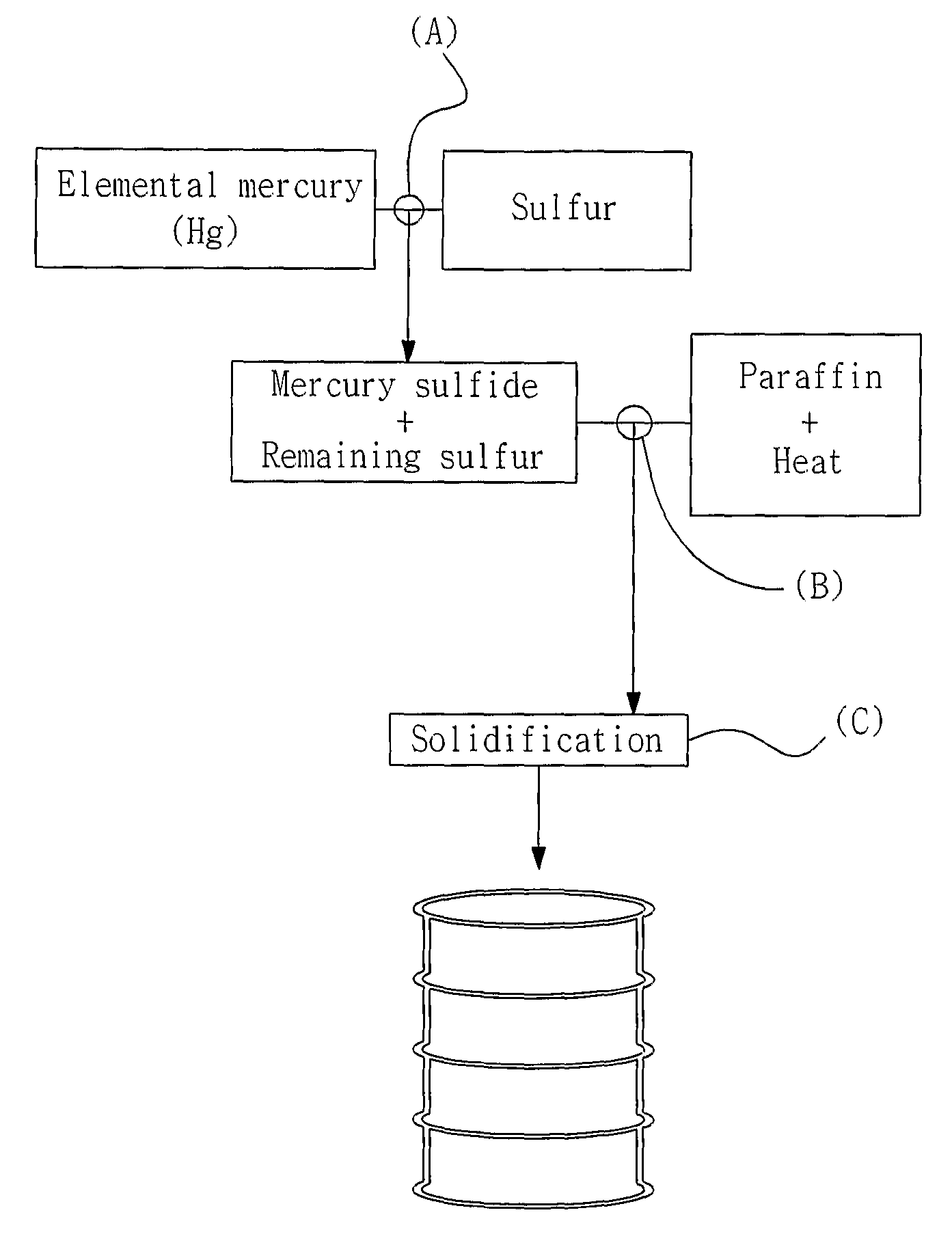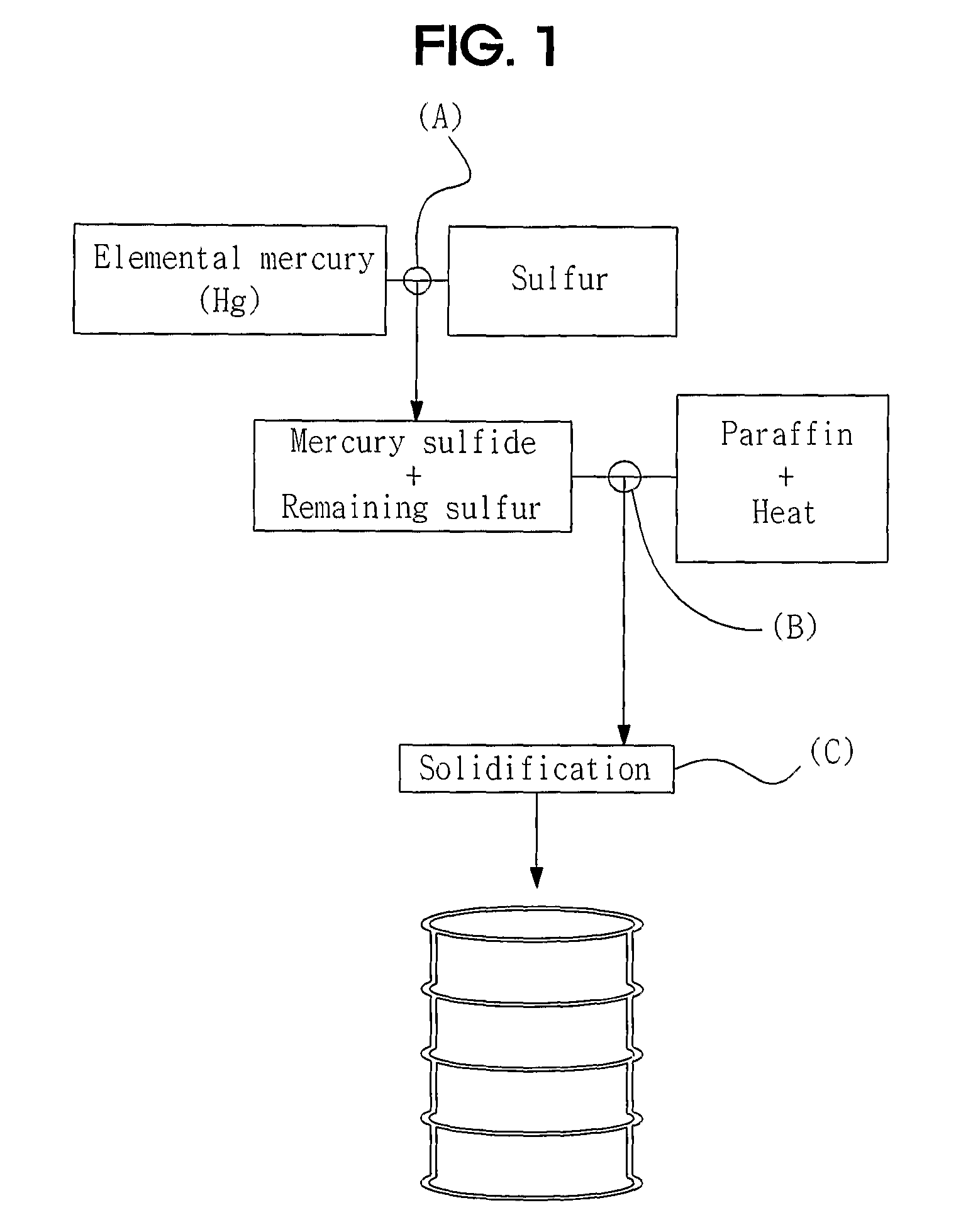Method of Stablizing and Solidifying Elemental Mercury Using Sulfur and Paraffin
a technology of elemental mercury and paraffin, which is applied in the direction of solid separation, chemical/physical processes, inorganic chemistry, etc., can solve the problems of difficult to induce direct reaction of elemental mercury, large increase in weight and volume of waste mixture, and dispersal of powdery mercury sulfide or storag
- Summary
- Abstract
- Description
- Claims
- Application Information
AI Technical Summary
Benefits of technology
Problems solved by technology
Method used
Image
Examples
example 1
Preparation of Solidified Elemental Mercury
[0038]15.46 g of sulfur and 1 ml of elemental mercury (about 13.56 g) were put into a vial which was then closed and sealed with a cap. Subsequently, the vial was shaken several times to mix the sulfur with the mercury, thereby obtaining a black mercury sulfide (HgS) compound. The HgS compound and remaining sulfur after the reaction were put into a constant temperature oven and heated at 75° C. for about 6 hours.
[0039]The bottle (vial) was put on a hot plate and heated to stabilize the mercury sulfide compound, and enough paraffin was then added to completely immerse the compound therein. The bottle was heated at 130° C., thereby preparing liquid paraffin. The stabilized mercury sulfide compound and the remaining sulfur were added to the liquid paraffin and heated to melt the mercury sulfide compound and the remaining sulfur into liquid. Then, the bottle was transferred from the hot plate to cool the liquid mercury sulfide compound and rema...
experimental example 1
Acid-Leaching Test of Solidified Product and Paraffin
[0040]0.491 g of the solidified product was taken from 27.58 g thereof (excluding paraffin) prepared in Example 1 for an acid-leaching test.
[0041]The acid-leaching test was carried out according to the EPA 7471B method suggested by the U.S. Environmental Protection Agency (EPA). This method, which can measure total concentration of organic and inorganic mercury, is used to estimate mercury in solid and semisolid waste.
[0042]According to the method, mercury in the stabilized solidified product may also be analyzed, after it is completely melted.
[0043]First, a part of a waste sample (about 0.5 g) to be analyzed was taken and put into a closed vessel for acid-leaching. 5 ml of sulfur, 2 ml of nitric acid and 5 ml of a 5% potassium permanganate were also added. After closing it with a cap, the vessel was put into a microwave to completely melt the sample into liquid at high temperature and high pressure. The liquid sample was analyzed...
experimental example 2
Elution Test of Solidified Product and Paraffin
[0046]The test was carried out according to the method described in Experimental Example 1, except that, in order to identify a more precise reaction ratio (weight ratio) of sulfur to mercury, various amounts of sulfur were added for repeated testing. In addition, an elution test for each of the solidified product and paraffin was performed according to a Toxicity Characteristic Leaching Procedure (TCLP).
[0047]The prepared solidified product was crushed into small pieces and all of the pieces were immersed in a TCLP elution test solution with a ratio of 1:20 (Solidified product:Eluted solution) for 18-hour elution.
[0048]16.46 g of the paraffin was taken for the elution test by the method described above. Analysis of the elution test solution was carried out using a Rumax Mercury Analyzer, and the analysis results are shown in Tables 3, 4, 5 and 6.
PUM
| Property | Measurement | Unit |
|---|---|---|
| Dimensionless property | aaaaa | aaaaa |
| Dimensionless property | aaaaa | aaaaa |
| Dimensionless property | aaaaa | aaaaa |
Abstract
Description
Claims
Application Information
 Login to View More
Login to View More - R&D
- Intellectual Property
- Life Sciences
- Materials
- Tech Scout
- Unparalleled Data Quality
- Higher Quality Content
- 60% Fewer Hallucinations
Browse by: Latest US Patents, China's latest patents, Technical Efficacy Thesaurus, Application Domain, Technology Topic, Popular Technical Reports.
© 2025 PatSnap. All rights reserved.Legal|Privacy policy|Modern Slavery Act Transparency Statement|Sitemap|About US| Contact US: help@patsnap.com



